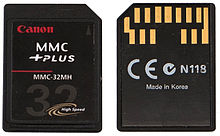Description
A memory card standard used for solid-state storage.
 32 MB MMCplus card | |
| Media type | Memory card |
|---|---|
| Capacity | Up to 512 GB |
| Developed by | JEDEC |
| Dimensions | Standard: 32 × 24 × 1.4 mm |
| Weight | Standard: ~2.0 g |
| Usage | Portable devices |
| Extended to | Secure Digital (SD) |
MultiMediaCard, officially abbreviated as MMC, is a memory card standard used for solid-state storage. Unveiled in 1997 by SanDisk and Siemens AG, MMC is based on a surface-contact low pin-count serial interface using a single memory stack substrate assembly, and is therefore much smaller than earlier systems based on high pin-count parallel interfaces using traditional surface-mount assembly such as CompactFlash. Both products were initially introduced using SanDisk NOR-based flash technology. MMC is about the size of a postage stamp: 24 mm × 32 mm × 1.4 mm. MMC originally used a 1-bit serial interface, but newer versions[when?] of the specification allow transfers of 4 or 8 bits at a time. MMC can be used in many devices that can use Secure Digital (SD) cards.
Typically, an MMC operates as a storage medium for a portable device, in a form that can easily be removed for access by a PC. For example, a digital camera would use an MMC for storing image files. Via an MMC reader (typically a small box that connects via USB or some other serial connection, although some can be found integrated into the computer itself), a user could transfer pictures taken with the digital camera to his or her computer. Modern computers, both laptops and desktops, often have SD slots, which can additionally read MMCs if the operating system drivers can.
MMCs are available in sizes up to and including 512 GB. They are used in almost every context in which memory cards are used, like cellular phones, digital audio players, digital cameras and PDAs. Since the introduction of SD cards, few companies build MMC slots into their devices (an exception is some mobile devices like the Nokia 9300 communicator in 2004, where the smaller size of the MMC is a benefit), but the slightly thinner, pin-compatible MMCs can be used in almost any device that can use SD cards if the software/firmware on the device is capable.
While few companies build MMC slots into devices as of 2018[update] (SD cards are more common), the embedded MMC (eMMC) is still widely used in consumer electronics as a primary means of integrated storage in portable devices. It provides a low-cost flash-memory system with a built-in controller that can reside inside an Android or Windows phone or in a low-cost PC and can appear to its host as a bootable device, in lieu of a more expensive form of solid-state storage, such as a traditional solid-state drive.
« Back to Glossary Index
